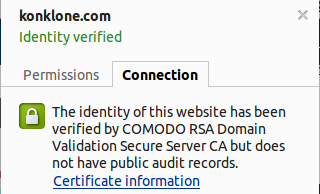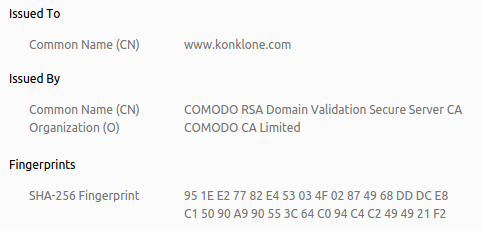Most of the secure web is using an insecure algorithm, and Google's just declared it to be a slow-motion emergency.
Something like 90% of websites that use SSL encryption —  — use an algorithm called SHA-1 to protect themselves from being impersonated. This guarantees that when you go to
— use an algorithm called SHA-1 to protect themselves from being impersonated. This guarantees that when you go to  , you're visiting the real Facebook and not giving your password to an attacker.
, you're visiting the real Facebook and not giving your password to an attacker.
Unfortunately, SHA-1 is dangerously weak, and has been for a long time. It gets weaker every year, but remains widely used on the internet. Its replacement, SHA-2, is strong and supportedjust about everywhere.
Google recently announced that if you use Chrome, then you're about to start seeing a progression of warnings for many secure websites:

The first set of warnings will hit before Christmas, and will keep getting more stern over the next 6 months. Eventually, even sites with SHA-1 certificates expiring in 2016 will be given yellow warnings.
By rolling out a staged set of warnings, Google is declaring a slow-motion emergency, and hurrying people to update their websites before things get worse. That's a good thing, becauseSHA-1 has got to go, and no one else is taking it as seriously as it deserves.
If you run a website that uses SSL, you can test your website using a small SHA-1 testing tool I built that will tell you what you need to do.
Even if you don't, I encourage you to read on. In the rest of this post, I'll cover how SSL and SHA-1 work together on the web, why it's as urgent as Google says it is, and what web browsers are doing.
As importantly, the security community needs to make changing certificates a lot less painful, because security upgrades to the web shouldn't have to feel like an emergency.
SHA-what?
To understand why replacing SHA-1 is so important, you have to put yourself in a browser's shoes.
When you show up to a website using  , the website presents a file — an SSL "certificate" — to your browser. This certificate is used to do two things: encrypt your connection to the website, and verify that you've connected to the real website.
, the website presents a file — an SSL "certificate" — to your browser. This certificate is used to do two things: encrypt your connection to the website, and verify that you've connected to the real website.
Any certificate can be used to encrypt your connection. But to verify that you're at the real Facebook, your browser has to have a way to decide whether to trust that certificate, and show you a green lock.
Your browser does this by figuring out whether the website's certificate file has been issued by a "Certificate Authority" (CA). CAs generally charge money to give website owners this file. Your browser trusts over 50 Certificate Authorities to create and vouch for certificates, ranging from Verisign to GoDaddy to the US Department of Defense — and the many hundreds of intermediary CAs to whom those 50+ have delegated trust. As you might guess, this is a veryflawed system, but it's the system that we have right now.
This website's Certificate Authority, for the time being, is Comodo, purchased throughNamecheap.

So another crucial test your browser demands, when a website's SSL certificate claims to be issued for that website by a particular Certificate Authority, is: can the certificate prove it?
Wherever practical, the internet proves things through math. When a certificate is issued, the Certificate Authority includes this proof by cryptographically "signing" the certificate using a private key, in a way only the real CA could do and that browsers can verify.
But the CA doesn't actually sign the raw certificate: it first condenses the certificate into a unique slug by running it through a "one-way hash" algorithm, like MD5, SHA-1, or SHA-256.

Using a one-way hash keeps things small: for example, running this exact 3.2MB version of War And Peace through SHA-1 gives you baeb2c3a70c85d44947c1b92b448655273ce22bb.

One-way hash algorithms like SHA-1 are designed to produce unique, irreversible slugs. You should not be able to take baeb2c3a70c85d44947c1b92b448655273ce22bb and work backwards and produce War And Peace. As importantly, no other file should produce that same slug — even changing one little period should cause the SHA-1 result to change so drastically as to be unrelated.
If two files are discovered to produce the same slug when run through a one-way hash like SHA-1, that's called a "collision". Collisions are always theoretically possible, but they're supposed to be so rare as to be practically impossible.
When your browser sees a certificate, it can calculate the SHA-1 for that certificate's information itself, and then compare it to the signed SHA-1 that the certificate offered as proof. Because SHA-1 promises unique slugs, the browser trusts that if they match, the certificate on offer is the same one the Certificate Authority signed.
If you could engineer a certificate that "collides" with a target certificate, and coax a Certificate Authority to issue you that certificate, then you would successfully forge a certificate that a browser would find indistinguishable from the target.
An attack on SHA-1 feels plenty viable to me
In 2005, cryptographers proved that SHA-1 could be cracked 2,000 times faster than predicted. It would still be hard and expensive — but since computers always get faster and cheaper, it was time for the internet to stop using SHA-1.
Then the internet just kept using SHA-1. In 2012, Jesse Walker wrote an estimate, reprinted by Bruce Schneier, of the cost to forge a SHA-1 certificate. The estimate uses Amazon Web Services pricing and Moore's Law as a baseline.
Walker's estimate suggested then that a SHA-1 collision would cost $2M in 2012, $700K in 2015, $173K in 2018, and $43K in 2021. Based on these numbers, Schneier suggested that an "organized crime syndicate" would be able to forge a certificate in 2018, and that a university could do it in 2021.
Walker's estimates and Schneier's characterization have become widely cited in the planning and debate over transitioning from SHA-1. A group of leading Certificate Authorities, the CA Security Council, cited them recently to complain about Google's schedule. In that complaint, the CAs use those estimates to suggest "the lack of a practical attack until 2018".
I find this to be an absolutely cartoonish stance for the CA Security Council to take in 2014. They are clearly rationalizing the issue, based on how inconvenient they think a more rapid transition would be.
Walker and Schneier's estimates were pre-Snowden, before the public properly understood that governments are adversaries too. By their estimates, a forged certificate in 2014 would cost less than $2 million, a sum that many determined actors in this world would pay.
How do we know that they would? Because they have.

In 2012, researchers uncovered a malware known as Flame. The Washington Post reportedthat this was a US-Israel collaboration to obtain intelligence from Iran to stall their nuclear weapons program, and a leaked NSA document seems to confirm this.
Flame relied on an SSL certificate forged by engineering a collision with SHA-1's predecessor, MD5. Disturbingly, it used a method that was not publicly known at the time, despite years of concerted research on MD5. This was a reminder that we should assume that the worst vulnerabilities go undisclosed.
And it's a funny story about MD5, because, like SHA-1, it was discovered to be breakably weak a very long time ago, and then, like SHA-1, it took a horrifying number of years to rid the internet of it.
MD5 was first shown to be theoretically weak in 1995, and over time was shown to be even weaker. But MD5 was still used by some Certificate Authorities until 2008, when researcherssuccessfully engineered a collision and got a forged certificate issued. That certificate, issued to "MD5 Collisions, Inc." has been immortalized inside your browser so that it can be specifically blacklisted.

That was an emergency, and yet Chrome wasn't able to remove support for MD5 until 2011 —16 years after MD5 was first shown to be untrustworthy.
That's because there's a particular challenge with updating signature algorithms on the internet today: as long as browsers need to support SHA-1 for someone, anyone's certificate can be forged with it. You can impersonate a SHA-2-signed cert with a SHA-1-signed forgery, because the browser will only be looking at the forgery and not know that there's a "real" cert or that that cert is "supposed" to be signed with SHA-2.
In other words, the only way to prevent certificate forgeries using SHA-1 is to remove SHA-1 support from browsers. Like a tumor, you have to get rid of it all.
What browsers are doing
Microsoft was the first to announce a deprecation plan for SHA-1, where Windows and Internet Explorer will distrust SHA-1 certificates after 2016. Mozilla has decided on the same thing. Neither Microsoft nor Mozilla have indicated they plan to change their user interface in the interim to suggest to the user that there's a problem.
Google, on the other hand, recently dropped a truth bomb by announcing that Chrome would show warnings to the user right away, because SHA-1 is just too weak:
We plan to surface, in the HTTPS security indicator in Chrome, the fact that SHA-1 does not meet its design guarantee. We are taking a measured approach, gradually ratcheting down the security indicator and gradually moving the timetable up.
Google's Ryan Sleevi had first announced Chrome's intended policy a couple weeks before, and I strongly recommend reading the full discussion — you will get to see many Certificate Authorities and large site operators show up and nervously attempt to reason with this wild-eyed man who appears to be telling them that they should stop issuing weak certificates not late next year, but right now.
This is a gutsy move by Google, and represents substantial risk. One major reason why it's been so hard for browsers to move away from signature algorithms is that when browsers tell a user an important site is broken, the user believes the browser is broken and switches browsers. Google seems to be betting that Chrome is trusted enough for its security and liked enough by its users that they can withstand the first mover disadvantage.
Opera has also backed Google's plan. The Safari team is watching developments and hasn't announced anything.
What you can do
To help with the transition, I've built a small website at shaaaaaaaaaaaaa.com that checks whether your site is using SHA-1 and needs to be updated:

Requesting a new certificate is usually very simple. You'll need to generate a new certificate request that asks your CA to use SHA-2, using the -sha256 flag.
openssl req -new -sha256 -key your-private.key -out your-domain.csr
I'm keeping track of issues and workarounds for getting SHA-2 certificates from various CAs. If you run into a problem not mentioned there, please ring in here and I'll update the site.
You may also need to update any SHA-1 intermediate certificate(s), as they're also verified using a digital signature. This means tracking down whether and where your CA has published their SHA-2 intermediates. I'm keeping track of SHA-2 intermediate locations for various CAs. If you find some not mentioned, or your CA doesn't have them yet, please ring in.
If you have a site but some other company controls the certs, email their customer support and tweet at them. Link to Google's announcement, and ask for their timeline.
I could also use some help on shaaaaaaaaaaaaa.com — if you feel like chipping in, check out the open issues and lend a hand.
Changing certificates shouldn't be this hard
There is a larger issue here: there's no reason that fixing security issues should be so aggravating. A big reason why websites and Certificate Authorities are dragging their feet on updating to SHA-2 is because it means reissuing certificates, and everyone hates replacing SSL certificates.
For individuals, the certificate process can be strange, filled with arcane terminology and confusing user interfaces.
For companies, certificates are generally obtained for as long as possible, stuck wherever, and forgotten about until it's time to panic. Certificate management is often outsourced or out of reach.
In discussing Chrome's new policy, Google's Ryan Sleevi makes this exact point — that security today means that changing your certificate can't be such a tremendous operational hassle:
The age of having a secure UI remain static for five years is no longer tenable. It is expected that sites be able to respond to and adapting to security threats. This applies whether you're talking about TLS protocol level attacks like BEAST, cryptographic attacks like those involved in certificate issuance, or application-level attacks such as mixed content.
For the vast majority of our users, security is a one-or-two bit state, not the gradiations that CAs may see. In this model, we need to accurately reflect to the user whether or not we believe they're secure.
...If a site is not capable of changing its cert within 12 weeks, then I think we have a far more serious security problem - as Heartbleed [has] taught us.
If you poke around Google's SSL configuration, you'll see that (!) they use certificates signed with SHA-1. But each certificate expires in 3 months, a short-lived window that reduces the chances that a certificate could be forged, while they migrate to SHA-2 in 2015.
As importantly, a 3-month window forces Google to make cert rotation operationally simple. This is the equivalent of Netflix's Chaos Monkey — forcing yourself to take entropy and change seriously by turning it from an emergency into the routine.
Google has made it somewhat easier for themselves to do this, by setting up a private intermediate certificate authority for themselves, signed by GeoTrust, that can reissue certificates on demand. But you don't need to own an intermediate CA to make frequent certificate rotation a part of your business processes — you need to prioritize it. That's what Google's doing, and that's what they're arguing we should all do.
In conclusion
A SHA-1 push like this should have started years ago. Any annoyance at Google for amping up the pressure should be channeled towards the Certificate Authorities instead, for allowing nothing to happen for so long.
For individuals, obtaining a certificate needs to be as easy as buying a domain name, installing it needs to be easy as turning on a website, and replacing it needs to be automatic. There are some pretty clear business opportunities and open source tooling gaps here.
For organizations, frequent certificate rotation needs to be prioritized in their infrastructure design and update processes. Organizations that have already done a good job of this should talk about it, and open source their work.
In the meantime, site operators should update their certificates and use the lack of Heartbleed-level urgency as an opportunity to revisit their SSL configuration and turn on things likeforward secrecy.
'malware ' 카테고리의 다른 글
| Arbitrary File Deletion as Root in Webmin (0) | 2014.09.10 |
|---|---|
| Threat Spotlight: “Kyle and Stan” Malvertising Network Threatens Windows and Mac Users With Mutating Malware (0) | 2014.09.10 |
| Identifying Firewalls from the Outside-In. Or, "There's Gold in them thar UDP ports!" (0) | 2014.09.10 |
| Demasking Google Users With a Timing Attack (0) | 2014.09.08 |
| Analysis of Chinese MITM on Google (0) | 2014.09.08 |